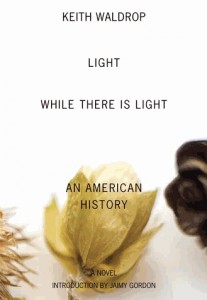 Light While There Is Light: An American History
Light While There Is Light: An American History
by Keith Waldrop
Dalkey Archive, 2013
220 pages / $14 Buy from Amazon or Dalkey Archive
“What I would like, I think, is to live a while longer. But not again.”
– Keith Waldrop
Light While There Is Light is called variously a fictional memoir, an autobiographical novel, and a masterpiece of twentieth century American fiction. I appreciate that the Dalkey Archive released it as Fiction. Somehow it feels better to call this a novel – and Waldrop seems to understand that. In reality I think that most readers assume a first person narrator should be equated with the author – what’s satisfying about this book is that it doesn’t seem to matter if you do or not. Despite the obvious allusions to the life of Keith Waldrop the person, and even the pictures that show Keith Waldrop the person in the text, this is a novel, not a memoir.
Compared to, say, Waldrop’s other work, this book is very accessible – readable even – and I’ve returned to it multiple times since receiving the book. I’ve enjoyed returning to it to go back and read a passage. It’s also illuminating (the book is full of light puns) to return and notice the kinds of motifs and themes that Waldrop uses throughout to create a kind of unified whole. It’s something that I would be happy to continue to read and reread, but also recommend that almost anyone read – It’s something that I’d recommend to friends, family members, writers, etc. There’s something to be learned from Waldrop’s sentences.
Despite what I would call a “straightforward” quality of the prose, every bit seems composed with intense attention to diction and pacing. It’s poetry, and it also bears poetry’s intense loyalty to peculiar internal logics:
Waldrop meanders through his own life thematically more than chronologically – though it does proceed in a relatively ordered fashion. Light Where There Is Light reminds me of W.G. Sebald’s books, and most specifically Rings of Saturn.
Both have the kind of detached, slightly melancholic, and drily humorous narrator, and easily shift from memory, to recollection, to reminiscence. There’s also the peculiar feeling that the narrator might not be trustworthy – or that the narrator might be fabricating half of the story (a kind of death of the author double bind, wherein the reader is trapped in the belief that at least the author is fabricating one story, instead of multiple layers of story) for the sake of symmetry or cohesion.
One anecdote, that Waldrop calls, “The spookiest story I ever heard,” near the beginning of the book, I actually wondered for a second if it was was from a book by Sebald – though I haven’t gone back to try to confirm or deny this suspicion. Not only was Light Where There is Light composed before Rings of Saturn, but it also seems completely irrelevant where the story comes from because it is so essential to this book., or at least to the understanding of the book. The little parable is so evocative – so essentially metaphorical and like a synecdoche for the whole work that it’s almost hard to believe that it’s anything but an invention of Waldrop’s.
The book starts as an origin story. It’s not really an origin story of Keith, the Narrator, but more like the beginning of the root cause of the series of family misadventures that form the book. The narrator’s own birth and conception remain obscure.
What the real focus on is the adventures and misadventures in the faith of the narrator’s mother, who only adopts more fundamentalist attitudes after her first husband disparagingly refers to her as a “Sunday school girl.” In a way, that frames the struggles of the narrator’s mother to find a kind of heaven on earth as hopelessly oppositional. She goes to battle with this conception that her first husband had of her by trying to confirm it.
Despite a disparate variety of goals and activities, Waldrop the narrator sees his family united under a ”dissatisfaction with the world.” With a tag line like that it is a sad story. Everyone dies. Death is unceremonious. It doesn’t matter much how hard you’ve work to transcend the flesh; you inevitably do.
It’s not a book that sucks you along with plot, but one that charms you with insight, and poetry. It’s a text of illumination, and I said, but it’s gradual. There’s no throwing the light on, but more like a slow burn. More of a gradual unfolding, or peeling back.
That’s probably why this is a novel, and why Waldrop sees it as possibly his most important work. In an anecdote in the introduction, both Keith and Rosmarie Waldrop are surprised by this minor revelation.
The book continuously unfolds to reveal symmetries and resonances that probably even the author didn’t suspect until afterwards. Unlike a memoir that careens through a narrator’s life to a logical redemption, Light Where There Is Life is a careful exploration – not teleologicallly driven, but transparent in its framing, its lenses, and its literariness (to use a rather stupid word). What I mean is that Waldrop takes a stretch of time and experience and creates from it a novel – a piece of literature – and that’s why it’s not a memoir or an autobiography.
Like Jaimy Gordon says in the introduction, this book is singular. There are probably others that bear similarities, but I can’t think of many that I’ve enjoyed reading and rereading more.
***
Leif Haven lives and writes and publishes poetry chapbooks as Persistent Editions in Oakland, CA.
Tags: Keith Waldrop, Leif Haven, Light While There Is Light: An American History
